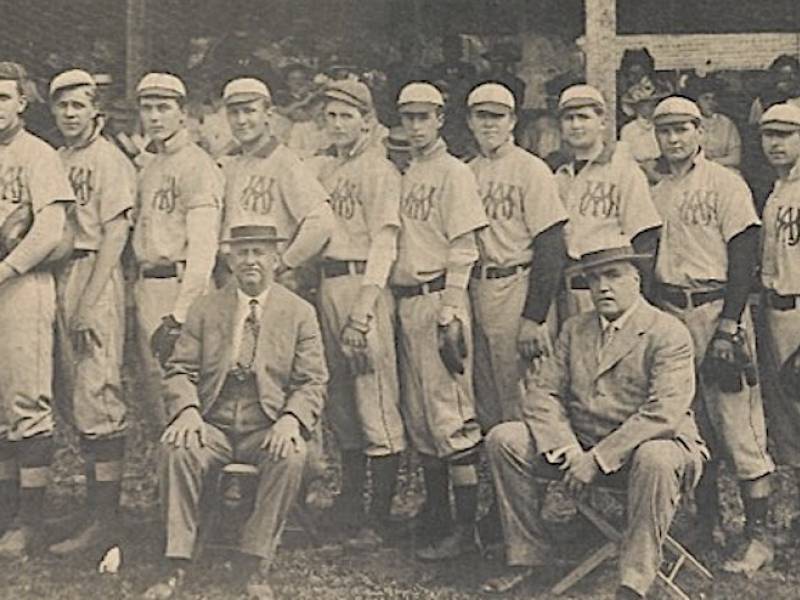
CUTLINE: This August 1908 picture shows the Marengo Athletics, a team that gained some degree of prominence between 1896 and 1901. It featured Carl “Lundy” Lundgren, who graduated from Marengo High School and then attended the University of Illinois before joining the Cubs. He played seven seasons and helped the Cubs to championships in 1906 and 1908. Lundgren, who possessed a fastball and sliding curve, struck out 103 batters in 1905 and finished his career with cumulative ERA of 2.42. The team played at Shurtleff Flats, where the Zion Lutheran athletic fields are now.
They were called the Excelsiors, White Stockings, Colts, Orphans, Spuds and Microbes before they became the Chicago Cubs in 1903, Bruce Allardice said during the April 10 presentation at the Huntley REC Center: Before the Chicago Cubs: Baseball Comes to the Windy City.
Allardice – prolific author and past president of the Northern Illinois Civil War Round Table and the Civil War Round Table of Chicago – is a member of the Society of American Baseball Research’s Biography Committee, which specializes in researching the lives of 19th Century ballplayers. You would be hard pressed to find any scrap of baseball lore that Bruce doesn’t know.
Let’s just say, don’t bet him concerning baseball trivia.
While popular culture says Gen. Abner Doubleday invented “base ball” in 1839 in Cooperstown, N.Y. Sixteen years after the death of Civil War Union Maj. Gen. Doubleday, a special commission in 1907 used flimsy evidence – stemming from mining engineer Abner Graves, who said he went to school with Doubleday – to come up with the origin story. Sanctioned by former player A.J. Spalding, it gained traction and stuck. But the actual story, Allardice said, is much older and more complicated.
It evolved from two English games: rounders, a children’s game brought to New England by colonists and cricket. But one could argue that ball-and-stick games have been around for centuries. What set baseball apart, Allardice said, was its speed of play (ironic now) and ease in which it can be played … compared to the plodding pace and 360-degree field used in cricket.
“Baseball is a 90-degree game,” he said. “It’s a lot easier to find space.”
Two sets of rules, originating in Massachusetts and New York, emerged in the 1850s. The former, which allowed players to plunk the runner with the ball to record an out, quickly fell out of favor with the players. After all, they already were fielding without the use of gloves. Bruises and broken fingers were plentiful.
Baseball’s origins are rooted in offense. The hurler’s job was to pitch the ball in a way that the striker could hit it. Strikes were not even introduced until 1858. Rules back then were more a matter of club compromise and umpire discretion. The New York Knickerbockers were the first the publish rules in 1848 and they continued to evolve into what we see today.
By 1870, Allardice said, there were more company teams than amateur. And as competitive appetites increased, merchants evolved into financiers. There were 158 Chicago clubs by the 1870s – not bad considering its population in 1860 was 125,000.
“Literally every healthy young man was playing baseball,”Allardice said.
There were games played in McHenry County as early as 1859. The Star of Marengo was earliest club, Allardice said, but other clubs forming in 1867 hailed from Harvard, Woodstock, Richmond and Algonquin. Union had a club in 1868, Hartland in 1870, Huntley in 1874 and McHenry in 1875. The first professional team was the Cincinnati Red Stockings in 1869. Feuds between it and Chicago for top hog butcher of the world honors, led Potter Palmer (of Palmer House fame) to create the Chicago White Stockings in 1869.
They hired the top talent from Eastern clubs, earning them the moniker of “mercenaries” or the “$18,000 club.” But this team of just 10 (that’s all they could afford) managed to defeat Cincinnati twice in 1870. The team, dissolved after the great Chicago fire of 1871, rejoined the National Association in 1874 and won six pennants. It became the Cubs.
Chicago’s American League squad, formed in 1901 a year after the league, adopted its version of an established name and became the White Sox.
– Kurt Begalka